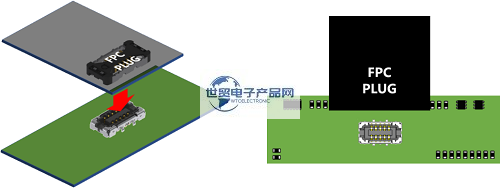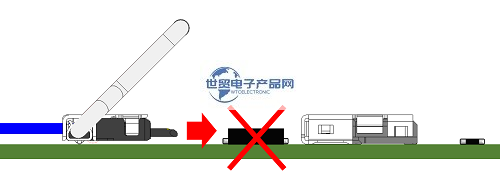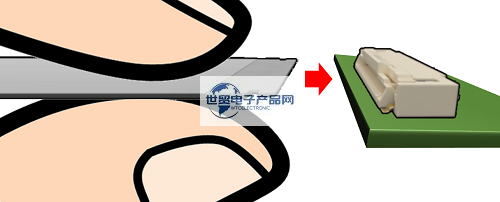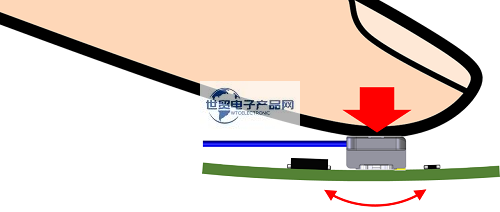Categorization:Product Information
There is a wide variety of connectors, so when developing new devices, it is necessary to find and select the most suitable connector. The following describes features related to different plugging and removing ways of small connectors for internal connection of electronic devices. When a cable, FFC or FPC is used to connect the signal of a PCB board to another board, a connector in which the connector is vertically close to the surface of the board, installed and fitted with it is called a vertical plug-in connector; The connector horizontally close to the board end is called a horizontal plug-in connector. (Below: vertical plug-in connector (left) and horizontal plug-in connector (right))

---------------------------------------------------------------------------------------------------------------------------------------------------------------------------------------------------------------------------------------------------------------------------------------------------------- This makes it easy to visually check and locate the job's insertion position by looking at the board from top to bottom during board assembly. (Bottom picture: vertical plug-in and unplug wire-to-board connector)
However, in the case of using a board-to-board FPC connector, it may be difficult for the operator to visually align the male to the correct insertion position for assembly because the FPC covers the entire male and blocks a clear view of the female on the board. (Below: Vertical plug-in and unplug board-to-board FPC connector)
In this case, it is important to provide a guide (calibration) function for the connector, which allows the user to use the sensation of the fingertip to find the correct insertion position while gently sliding the FPC male onto the female. (Below: Board-to-Board FPC Connector Rail Function)
2. Installation position on the board and gap with other components: For vertical plugging and unplugging connectors, the male seat is close to the female seat on the board from above and plugged and unplugged, so even if the connector is located in the middle of the board, it is not difficult to plug and unplug the connector. Additionally, since the required movable clearance area around the connector is relatively narrow, other components may be mounted around the connector. Therefore, in terms of design, the vertical plug-in type connector provides more flexibility than the horizontal plug-in type. (Below: On-board vertical plug-in connectors and other component boards)
On the other hand, for horizontal plug-in connectors, the opening of the female socket is facing one side, so the male socket needs to be moved parallel to the surface of the board end to fit with the female socket. Therefore, it needs to be installed with a larger clearance area around the opening direction of the female seat at the board end to ensure that there is no obstruction during plugging and unplugging. (Below: horizontal plug-in wire-to-board connector, horizontal plug-in connector and gap area)

 In addition, if a low height horizontal plug-in connector is installed in the middle of the board, the assembly process may become difficult because the finger holding the FPC/FFC or male will touch the end of the board during fitting. When designing a circuit board, it is necessary to consider the assembly process. For example, low-height horizontal plug-in connectors are usually placed at the edge of the circuit board. (Below: Insert the FPC into the horizontal plug-in FPC/FFC connector)
In addition, if a low height horizontal plug-in connector is installed in the middle of the board, the assembly process may become difficult because the finger holding the FPC/FFC or male will touch the end of the board during fitting. When designing a circuit board, it is necessary to consider the assembly process. For example, low-height horizontal plug-in connectors are usually placed at the edge of the circuit board. (Below: Insert the FPC into the horizontal plug-in FPC/FFC connector)
3. Connector height and effective fitting length: Since the effective fitting length is affected by the direction of plugging and unplugging, for vertical plugging and unplugging connectors, the effective fitting length is affected by the length perpendicular to the board direction, that is, the height dimension of the connector. In portable high-performance devices, such as smartphones and tablets, components require high-density installation in narrow and confined spaces. In such devices, small component size and shape are required, but when the height of the vertical plug-in connector is reduced, it may be difficult to maintain a sufficient effective fitting length. (Below: Vertical Plug-in Connector and Effective Fitting Length)
For horizontally pluggable connectors, the effective fitting length is affected by the length parallel to the horizontal direction of the end surface of the board, i.e. the depth dimension of the connector. Therefore, it is easier to consider lowering the height of the horizontal insertion type connector while maintaining the effective fitting length as compared to the vertical insertion type connector. (Below: horizontal plug-in connector and effective fitting length)
4. Fitting retention force of low-height connectors: A shorter effective fitting length means higher tolerance ranges between terminals at fitting positions. Therefore, there may be a high chance of loss of contact between the terminals, for example, when the device is suddenly dropped and then moved to the fitted position. One of the ways to improve the reliability of contact contact is to strengthen the fitting retention between the male and female seats by using locking mechanisms such as friction or mechanical locks. Furthermore, another way to supplement the fitting retention of the vertical plug connector is to attach suitable cushioning material over the connector. (Below: Example of mechanical lock for vertical plug-in connector)

Thus, when the product housing is attached, the cushioning material properly compresses the connector and secures the connector fitting position. This method can be considered for use when developing small portable devices, for example, when carrying small devices, there is a possibility of falling. (* However, be careful not to apply excessive pressure to the connector as this may cause damage. ) (Lower: Cross-sectional image of the housing body and cushioning material above the connector.) (Bottom: Cross-sectional image of the housing body and cushioning material)
5. Insertion force effect: Since the vertical plug-in connector is fitted by inserting the male seat into the board end, a vertical plug-in connector with high insertion force may exert excessive pressure on the board end during the fitting process. Therefore, when assembling a board that is not suitable for applying pressure, such as the board of a flat integrated module, some measures may need to be taken, such as selecting a vertical plug-in connector with low plug-in force, preparing an assembly environment that does not cause the board to deform, or selecting a horizontal plug-in connector. (Bottom Figure: Fitting of Vertical Plug-in Connector with High Insertion Force) (Bottom Figure: Fitting of Vertical Plug-in Connector)

6. Summary of the characteristics of vertical/horizontal plug-in connectors:
| Vertical plug-in connector | Horizontal plug-in connector |
| Compared with horizontal plug-in connectors, the required clearance area around the connector is narrower, providing more flexibility in designing the board. | Since the gap area near the connector opening is relatively wider, unusable space is likely to be created on the board. |
| Even installing the connector in the middle of the board does not affect the plugging and unplugging process much. | In cases where the connectors are low and small, the fitting of the connectors mounted in the middle of the board may become difficult. |
| It may be difficult to reduce the height of the connector while maintaining an effective fitting length. | Compared to vertical plug-in connectors, it is relatively easy to reduce the height of the connector while maintaining an effective fitting length. |
| When fitting high insertion force connectors, excessive pressure may be applied to the plate ends. | The pressure exerted on the board during assembly may be less than when assembling the vertical plug-in connector. |
-----------------------------------------------------------------------7. About Shimao Electronic Product Network Platform Introduction and Sales Products Brief Description: Shimao Electronic Product Network is a professional, accurate and vertical comprehensive product sales platform for the electronic industry focusing on the supply, demand and sales of connector harness and cable products! Specializing in the production/sales of {Connector Harness Cable Products}; If you have purchase/purchase, sales/resource and promotion needs of [small connector products for internal electronic equipment], please contact us through the following methods.